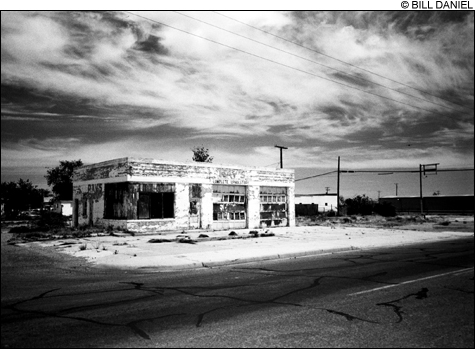
ONE IN A SERIES “Dead Gas Stations of the Permian Basin,” photograph by Bill Daniel. |
Bill Daniel doesn't call the landlord when there's a hole in the roof. He just turns the damn house into a boat.
Filmmaker, collector, survivalist, and Texan, Bill Daniel has made a career out of the art of repurposing. His photography and collected ephemera represent a lifetime tracing fading graffiti, forgotten referents, and failing abodes. Though his work isn't limited to archived moments of marginal music from the Reagan era, a punk ethos haunts his investigations like a neck tattoo on a bank teller. In "Ground Score" he approaches his subject — the deterioration and resistance of the American South — with an unsentimental eye and marginal focus.
Thematically, Daniel deals in four settings: the collapsing Southern city, its teeming subculture, the offshore domain, and riding freight. Through black-and-white 8-by-10-inch print photographs and often-photocopied bricolage, Daniel's work so tirelessly plots the coordinates of a radical and itinerant life in the South that the final product becomes a city of its own. And compared to some of the places he's lived, this city — although conceptual — is presented as much more inhabitable.
If a single photograph of the charred structure of a former BP service station is a footnote, a series of them ("Dead Gas Stations of the Permian Basin 1-4") conjures a sort of battlefield. In another photograph ("Concealed, TX, 1996"), the message "Concealed Handgun Course Sept. 16th @ Aledo Comm Center 613-1273" is spray-painted on the walls of a tiny shack in what appears to be the middle of nowhere. In the "Sausalito Houseboat 2002" series, a harbored vessel attests to the Bill Daniel the raft-punk, another of his many paths off the grid.
Beyond the photos, much of what comprises the "Ground Score" installation appears to be fodder for a personal scrapbook. A lyric sheet of songs by an un-Google-ably obscure Texas band. A not-for-sale photograph of a telephone pole whereupon so many fliers were posted that its decorous stripes of old staples are treated as subject rather than frame. An egg-crate foam mounted on the wall contains the shape of such a familiar tarnish that it's understood as a makeshift mattress. On occasion, the tone shifts from survivalist to existentialist to apocalyptic, where the material world may be crumbling and vulnerable. In one instance, a piece of particularly vociferous religious propaganda advocating messianic mass suicide is juxtaposed against a Critical Mass pamphlet prophesying a bicycling spike after the next Katrina hits. An interactive installation piece is a "trading blanket," a marketplace of pocket offal (think business cards, a Cinnamon Brach's, a crushed half-pack of gum) heralded by a sign declaring "your money is no good here."
If Daniel's collection starts to seem like a slapdash paean to the joys of disorder, consider the alternative. The American steel, steam, and oil cities he has lived and worked in are becoming increasingly abandoned and destitute. "Ground Score" doesn't so much celebrate a punk lifestyle as simply present what he finds, in working order, a major contrast to the mainstream landscape. Indeed, the only actual activity to be found in "Ground Score" happens in dimly lit basements of thrashing youth — everything else is a monument of disutility, failure, or escape. In an American homeland full of leaks, Daniel is right to go underground.